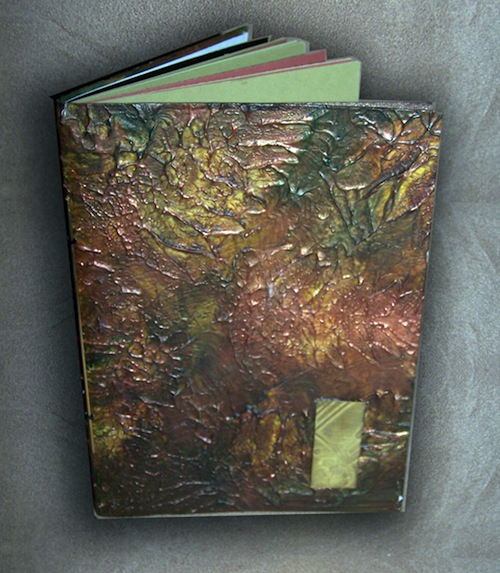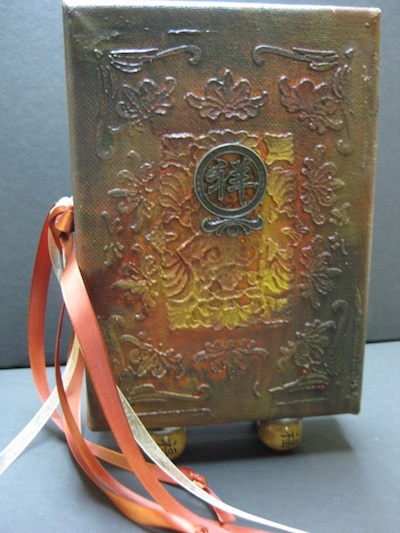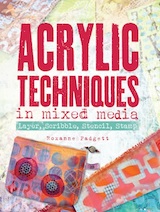How to Make Sculpting Mixture for Mixed Media Art
A invitee mail by Jacqueline Sullivan
One of my very favorite mediums to play with is Acrylic Molding Paste (as well called Modeling Paste). For me and my art and collage work, it's all most texture and ane of the all-time ways to get a textural surface is by using this paste.

But just what is it? Molding, or modeling paste is an acrylic medium that is filled with solid material. The upshot is a thick "viscid" white substance that can create a controlled textural surface. Molding paste is an opaque white when it dries.
I primarily employ the Golden brand of molding paste, although I take used Liquitex and other "store brands". Each brand has it's own unique qualities and I recommend that yous go in with a few friends and each purchase a dissimilar blazon/brand of the pastes and/or other mediums and practice a small study to see which you lot adopt.
Golden makes several types of molding paste. The ones that I use are molding paste, low-cal molding paste and hard molding paste.
The light has a very calorie-free foamy sort of texture and does look a bit different from the others. It is also a scrap more flexible than the other two pastes, making it amend for altered book pages that are going to get moved most a bit more. Information technology is likewise good for very large works of fine art. The work will have less overall weight. This product can too be used as a lightweight "filler" for paints. Information technology has a more absorbent surface than the others and so I tin can apply information technology with thinner paints as well as pastels.
Molding Paste has a slightly grayer colour than the light molding paste and a higher density. When dry, the surface of molding paste is quite a chip harder than the light molding paste. Information technology does non hold as high of a summit every bit the light molding paste. You can carve into molding paste.
Hard molding paste is non every bit flexible equally either molding paste or the lite molding paste. The hard molding paste tin be shaped with a knife, carved and /or sanded. The only time that I accept ever used hard molding paste was to obtain a smooth raised stencil on a piece of furniture. I was able to sand information technology smooth enough that it became an integral part of the article of furniture surface.
When using molding paste, I apply either newspaper or canvas for a substrate. The paper that I favor is 140 lb. cold press watercolor newspaper. Information technology is heavy enough to take the weight of the paste. Merely it is however calorie-free enough to tear and cut hands to build up layered collages.
Yous can add acrylic pigment to all of the molding pastes to tint them. But the pastes are white and therefore they lighten the color that is added. I first build my textures with the molding paste and so paint them with fluid acrylics. This likewise allows me to blend and coat with the color, getting a skilful mixture of color and texture.
My favorite matter to do with molding paste is to stencil with information technology. You lot can use either plastic or contumely stencils to do this. Y'all volition get a sharper definition of your image with the brass stencils. Only sometimes, the plastic stencils are a better option because you lot become a better integration with the surface. For background textures I prefer less definition. For textures that I am going to use every bit a focal point I like the higher definition of the metal stencils. The all-time tool that I have establish for stenciling with molding paste is a plastic palette knife. The handle of the pocketknife keeps my fingers out of the paste and the flexibility of the knife allows me to push the molding paste downwardly into the open areas of the stencil.
I identify a "glop" of molding paste – either the regular or light molding paste – onto the stencil. I then scrape it over the stencil evenly with the palette knife. In one case it is spread evenly over the stencil, I take the side of the knife and flake off the excess paste. The only paste and then left, is that which is in the open up areas of the stencil. The other areas of the stencil take been scraped well-nigh clean. Once you take reached this phase, carefully and slowly elevator up the stencil. Voila! Y'all will have a raised image on your paper or canvass!
For a slightly different technique, put a modest amount of molding paste onto your substrate before putting downwards the stencil. So proceed as above. When yous pull up the stencil it will pull away some of the previously laid paste and y'all volition get the image from the stencil on acme of another texture (encounter Asian Adult female collage for an example of this technique).
In improver to stencils I besides put push button and scrape molding paste through sequin waste material and various types of produce numberless. Using these things you can get various shapes of texture, circles, square and diamonds.
Another mode that I get texture with molding paste is by "pulling" it. To accomplish this, I utilize two pieces of paper. Spread the molding paste on one slice of paper rather thickly. Place some other slice of paper on tiptop of this and twist slightly. Pull the 2 pieces of newspaper apart and you lot will have an organic looking "hills and valleys" type texture. If you are not pleased with the way that it looks, merely do it again! The more you twist, the more "plant-similar" the texture becomes. For variety, I like to glaze the paper with black gesso starting time. I permit the gesso dry and then practise the "pulled molding paste". Since the molding paste is translucent, the blackness shows through. And so if you paint the molding paste with transparent colors you go a very "shadowy" look. The background of the layered collage in the photo was done this way.
Yous can too stamp into the molding paste. Since it is sticky and rather hard to remove, I wouldn't recommend using your favorite condom stamps in the paste. I utilize the inexpensive cream stamps that are made for stamping walls. The paradigm that you achieve by stamping into the paste is very indistinct, but can be quite beautiful when it is painted. The leaf texture in the photo was done this way.

I allow the molding paste to dry before I paint it. The time will vary depending on how thickly you have applied the molding paste and the humidity weather. It is commonly at least 45 minutes before I feel that the surface is dry out plenty to paint. I pigment with Gold fluid acrylics. You tin can thin them with a fleck of water, but if you get too much water in the pigment the molding paste will resist the pigment. This is where you volition discover a real difference in the diverse types and brands of molding/modeling pastes. They all accept the paint a fleck differently. I usually start painting with Quinacridone Nickel Azo Gold. It is a very transparent colour and is a very warm color. An under glaze of this color imparts a warmth to all the colors on top of it. I then proceed, painting and mixing the colour every bit I become. Ane of my favorite combination of colors is Quinacridone Nickel Azo Gold, Quinacridone Burnt Orangish, Jenkins Greenish, and Irised Copper. These are Golden colors, only you lot tin can formulate a like palette with other brands. I like the intensity of the Golden colors.
I will oft work for several hours creating all sorts of textures on paper. Then, on another day I will paint and foil the textured papers. They then go into the basket of "collage papers". I will after dig through my collection and build my layered geometric collages, which I have get obsessed with over the last few years.
Because the molding paste is so flexible, information technology can too be used for volume covers. I sometimes just fold the papers in half and sew some signatures in, forming a small highly textured journal. I also do my techniques on volume board, I then sand and pigment the edges. I drill holes in these boards and bind them with a Coptic stitch to form a larger periodical.

Start playing with this versatile medium and meet what sort of textures you can come up with. I guarantee you, if you similar textural surfaces, you volition become as addicted to this medium as I am!
Jacqueline Sullivan is a mixed media, acrylic and calligraphic creative person and is known for experimenting with texture, layers, paint and unusual materials. Jacqueline is also a teaching creative person instructing in both the U.s.a. and Canada. She has published technique manufactures and produced art instruction DVDs. Jacqueline can exist reached via her website www.jacquelinesullivan.com.
 For more than acrylic techniques, endeavour Roxanne Padgett's book, Acrylic Techniques in Mixed Media: Layer, Scribble, Stencil, Stamp.
For more than acrylic techniques, endeavour Roxanne Padgett's book, Acrylic Techniques in Mixed Media: Layer, Scribble, Stencil, Stamp.
More RESOURCES FOR MIXED MEDIA ARTISTS
* Find great books, DVDs, downloads & more for mixed media artists!
* Sign up for your Free email newsletter for great tips, projects & more…
* Download gratis mixed media desktop wallpapers!
Source: https://www.createmixedmedia.com/blogs/acrylic-molding-paste